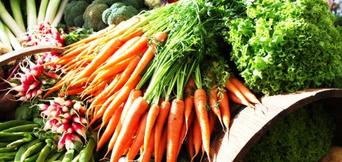Call us at: 617-244-1966
Sacred Pathways to Universal Consciousness: The Energy and Power of Food
The energy and power of food in our lives can be appreciated through our conscious choices. For example, if we choose warming foods during the winter, we stay warm in the cold. If we choose cooling foods in the winter, we feel cold in the cold. Foods are best chosen by an understanding of their energy.
There are various warming foods and various methods to make plant foods warming depending on your location. Here in New England, the external weather in winter is cold. Cold is "yin" in macrobiotic terminology. Yin is considered expanding, upward energy which creates the need for the contracting energy of "yang" for balance. Heat or hot is "yang." Yang is the contracting, downward energy, which creates the need for the expanding energy of "yin" for balance. Each energy is constantly changing throughout the seasons. In a yearÕs time, winter changes into spring, spring into summer, summer into fall, and fall into winter again. Likewise, the energy of cold changes to a mild climate, to warmth, to hot, to a milder climate, to cold again.
The "yinizing", expanding effect of the cold of winter that causes the "yangizing" effect of contraction can be seen in the gradual change of plants from summer to winter. In the summer, the leaves of trees and other plants are full, green, and luscious. As autumn approaches and the temperature drops, the plant life changes. The colors of fall are greatly a result of plant life loosing their water content, dehydrating. They are "yangizing" to balance the "yinizing" effect of the drop in temperature. As winter approaches, they change to a brown color, wilt, and fall to the ground. As the January cold approaches, the trees become completely barren and most plants die or become dormant. The water in the leaves of the trees has been totally squeezed out, evaporated and/or returned to the soil. Evergreens stay green because they are more "yang." All is in balance, in harmony with the changing of seasons, all year long, from the luscious water-filled green leaves to the beautiful colors of autumn to the dead, brown barren leaves. No thinking, just being.
Animals in the wild naturally live in harmony with this natural cycle. They eat what is available. Eating balancing foods throughout the year, they keep warm in winter and cool in summer. Because of the wide variety of store bought foods available to human beings, we need to be more conscious about choosing nourishing and warming foods if we want to stay warm in the cold weather, (and cooling foods if we want to stay cool in the warm weather). Eating primarily cooked root vegetables, such as burdock, carrots and parsnips, long timed cooked stews, strong miso soups, and some pressure-cooked and baked grains, such as brown rice and millet, are an ideal way to stay warm and healthy during the winter months. The downward contractive energy of foods that are grown under the soil, that are harvested in the fall and stored during the winter are the ideal warming winter foods for our health.
When we select these foods, we can better adapt to the cold. Being that the cold is "yin," we need to "yangize." Eat yin foods like fruit, bananas, and lots of liquids and you will be cold in the cold. (A side bar here: Since we are living in heated homes, it is okay to have some "yin." How much? Give me a call.)
Our understanding of the energy of food and eating in harmony with the changing seasons is a sacred pathway for our health and well being. Our developing consciousness is our greatest asset as we determine which foods will keep us warm and which will keep us cool.
Recipes for an ideal hearty winter meal:
CREAMY PARSNIP SOUP: I get the most compliments at my Friday night dinners for my creamy soups. This one is so easy, anyone can do it. SautŽ one chopped onion in sesame oil in a pressure-cooker. Add a teaspoon of Celtic Sea Salt and cook until the onions are translucent. Add a half dozen chopped parsnips, let them cook a minute. Add 2-3 cups of cooked grain like rice or oatmeal and then add 4-5 cups of water. Close the pressure-cooker, bring the pot to pressure and let it simmer for 5 minutes. After the pressure is down, blend the parsnips, water and onions in a blender. The creamy mixture returns to the stove in a pot. Add 3 tablespoons of White Miso from the South River Miso Co. (Made in Conway, Mass.) Stir to mix and let simmer for 1 minute. Add a garnish of chopped dill and you have the most delicious soup for keeping warm in the winter.
PRESSURE-COOKED BROWN RICE: Place 3 cups of organic brown rice in a pressure-cooker and rinse three times. This allows any sediment or dust to wash away. Add 5 cups of water and a teaspoon of Celtic Sea Salt. Close the pressure-cooker and place it on a hot or high flame and bring to pressure. In 7-8 minutes, the pressure will be up, the pressure gage will giggle. Lower the flame, place a flame tamer under the pressure-cooker and let the rice cook for 35 minutes. After the rice is cooked, let the pot stand for a number of minutes and allow the pressure to go down gradually. Open the pressure-cooker and serve the rice steaming hot.
BAKED ROOT VEGETABLES: This too is simple. Cut various root vegetables, onions, carrots, parsnips, rutabaga, turnips, and burdock into small chunky, bite-size pieces and place in a large baking dish with a piece of kombu sea vegetable. Sprinkle olive oil, garlic and a squeeze of ginger. (Various other spices like sage, rosemary and thyme are for individual taste preferences.) Add just enough water to cover the bottom of the baking dish and place in an oven at 375 degrees for about an hour or until the vegetables are soft.
STEAMED VEGETABLES: What could be easier? Cut up some kale, collards, broccoli, and place them in a pan with a splash of water, bring the water to boil and let steam for 5 minutes. For heartier steamed vegetables, add a teaspoon of umeboshi plum for a saltier taste.
AMASAKE PUDDING: This one is a no-brainer. Buy Amasake, (the best is from the Kendall Co.), and cook it on the stove in a saucepan. Mix a bit of kuzu in cold water and add to the boiling amasake. Cook until the white liquid turns clear. Serve HOT.
Enjoy! May your winter be warm and healthy!
David Snieckus is a graduate of the world-renowned Kushi Institute, and has been practicing Macrobiotics since 1977. His passion is to share his knowledge and experience and invoke self-awareness in others so that they may experience optimum health and happiness. For information on Macrobiotic consultations, cooking classes, catering services (including for retreats), community dinners, and "David's Take-Out", contact David at (617) 964-2951 or davidsnieckus@hotmail.com.


